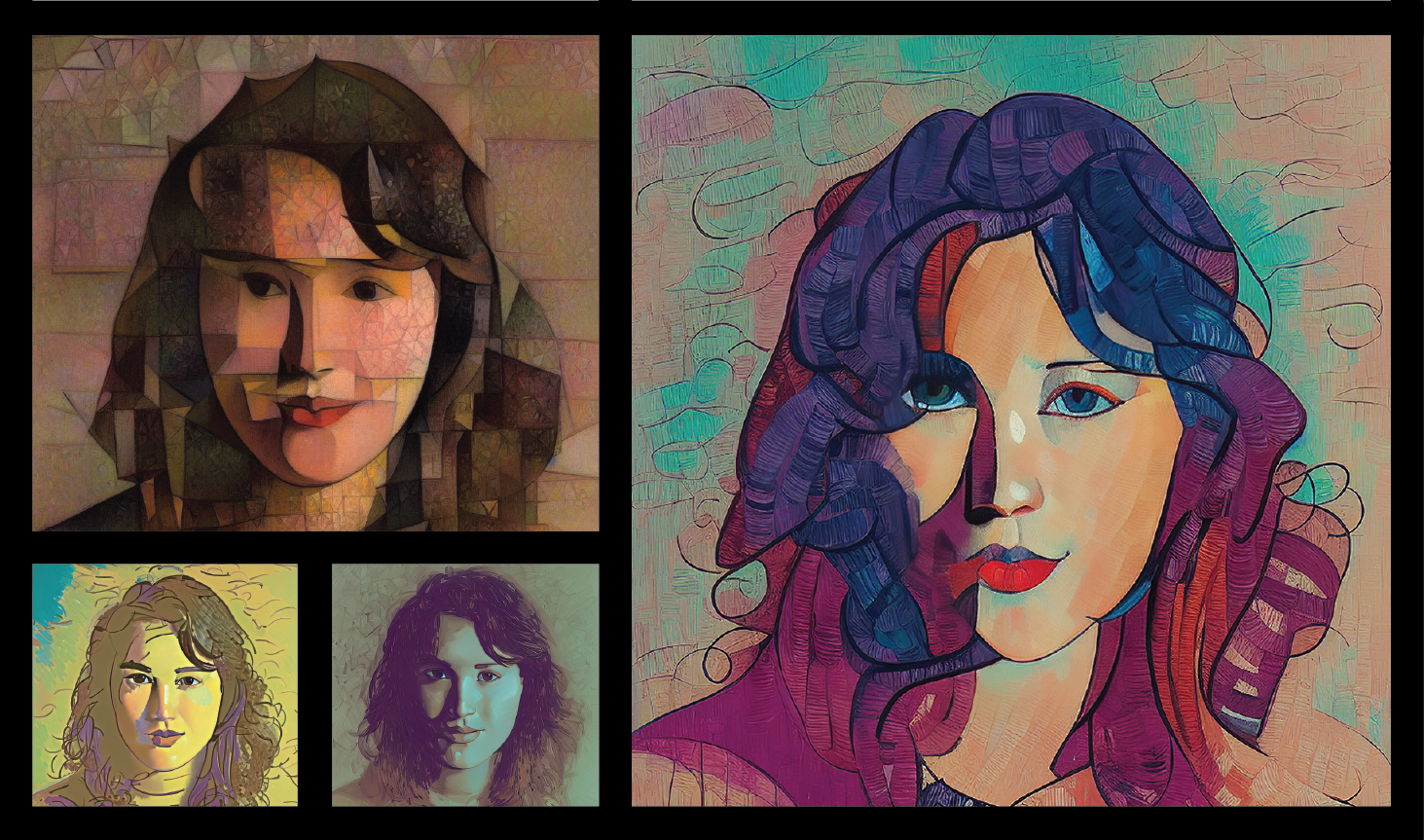References
1AbukhodairN.SongM.PekçetinS.DiPaolaS.2024Designing a wheel-based assessment tool to measure visual aesthetic emotionsCogn. Syst. Res.8410119610.1016/j.cogsys.2023.101196
2AchlioptasP.OvsjanikovM.HaydarovK.ElhoseinyM.GuibasL. J.2021ArtEmis: Affective language for visual artProc. IEEE/CVF Conf. on Computer Vision and Pattern Recognition115691157911569–79IEEEPiscataway, NJ
3Alameda-PinedaX.RicciE.YanY.SebeN.2016Recognizing emotions from abstract paintings using non-linear matrix completionProc. IEEE Conf. on Computer Vision and Pattern Recognition524052485240–8IEEEPiscataway, NJ10.1109/CVPR.2016.566
4BalajiY.NahS.HuangX.VahdatA.SongJ.KreisK.AittalaM.AilaT.LaineS.CatanzaroB.KarrasT.
5Becker-AsanoC.IshiguroH.2009Laughter in social robotics—no laughing matterProc. Int’l. Workshop on Social Intelligence Design287300287–300Springer
6CetinicE.LipicT.GrgicS.2019A deep learning perspective on beauty, sentiment, and remembrance of artIEEE Access7736947371073694–71010.1109/ACCESS.2019.2921101
7CoyneA.MurtaghA.McGinnC.2020Using the Geneva emotion wheel to measure perceived affect in human-robot interactionProc. 2020 ACM/IEEE Int’l. Conf. on Human-Robot Interaction491498491–8ACM/IEEECambridge, UK10.1145/3319502.3374834
8da PosO.Green-ArmytageP.2007Facial expressions, colours and basic emotionsColour: Design and Creativity12
9DiPaolaS.2009Exploring a parameterized portrait painting spaceInt. J. Art Technol.2829382–93
10DiPaolaS.2017Exploring the cognitive correlates of artistic practice using a parameterized non-photorealistic toolkitLeonardo50452453452–310.1162/LEON˙a˙01491
11DiPaolaS.GaboraL.2007Incorporating characteristics of human creativity into an evolutionary art algorithmProc. 9th Annual Conf. Companion on Genetic and Evolutionary Computation245024562450–6ACMNew York, NY10.1145/1274000.1274009
12DiPaolaS.GaboraL.McCaigG.2018Informing artificial intelligence generative techniques using cognitive theories of human creativityProcedia Comput. Sci.145158168158–6810.1016/j.procs.2018.11.024
13DiPaolaS.McCaigG.2016Using artificial intelligence techniques to emulate the creativity of a portrait painterElectronic Visualisation and the Arts (EVA 2016)158165158–65BCSSwindon, UK
14DiPaolaS.McCaigG.CarsonK.SalevatiS.SorensonN.2013Adaptation of an autonomous creative evolutionary system for real-world design application based on creative cognitionProc. Fourth Int’l. Conf. on Computational Creativity (ICCC)404740–7University of Sydney
15DukeD. J.BarnardP. J.HalperN.MellinM.2003Rendering and affectComput. Graph. Forum22359368359–6810.1111/1467-8659.00683
16GendallP.HoekJ.GendallK.2018Evaluating the emotional impact of warning images on young adult smokers and susceptible non-smokersJ. Health Commun.23291298291–810.1080/10810730.2018.1440332
17HevnerK.1935Experimental studies of the affective value of colors and linesJ. Appl. Psychol.19385398385–9810.1037/h0055538
18JoshiD.DattaR.FedorovskayaE.LuongQ. T.WangJ. Z.LiJ.LuoJ.2011Aesthetics and emotions in imagesIEEE Sig. Process. Mag.289411594–11510.1109/MSP.2011.941851
19KorovinaO.CasatiF.NielekR.BaezM.BerestnevaO.2018Investigating crowdsourcing as a method to collect emotion labels for imagesExtended Abstracts of the 2018 CHI Conf. on Human Factors in Computing Systems161–6ACMNew York, NY10.1145/3170427.318866
20LederH.RingA.DresslerS.2013See me, feel me! Aesthetic evaluations of art portraitsPsychol. Aesthet. Creat. Arts7358369358–6910.1037/a0033311
21MardiaK. V.1975Statistics of directional dataJ. R. Statist. Soc. Ser. B: Statist. Method.37349371349–7110.1111/j.2517-6161.1975.tb01550.x
22McCaigG.DiPaolaS.GaboraL.
23MohammadS.KiritchenkoS.2018WikiArt Emotions: An annotated dataset of emotions evoked by artProc. Eleventh Int’l. Conf. on Language Resources and Evaluation (LREC 2018)European Language Resources Association (ELRA)
24PeirceJ. W.2009Generating stimuli for neuroscience using PsychoPyFront. Neuroinform.2343
25
26SamuelsonP.2023Generative AI meets copyrightScience381158161158–6110.1126/science.adi0656
27SchererK. R.2005What are emotions? And how can they be measured?Soc. Sci. Inform.44695729695–72910.1177/0539018405058216
28SchulzK.Hayn-LeichsenringG. U.2017Face attractiveness versus artistic beauty in art portraits: A behavioral studyFront. Psychol.8191–9
29SeoS.KangD.2016Study on predicting sentiment from images using categorical and sentimental keyword-based image retrievalJ. Supercomput.72347834883478–8810.1007/s11227-015-1510-0
30TschöpeN.ReiserJ. E.OehlM.2017Exploring the uncanny valley effect in social roboticsProc. Companion of the 2017 ACM/IEEE Int’l. Conf. on Human-Robot Interaction307308307–8ACMNew York, NY10.1145/3029798.3038319
31ValdezP.MehrabianA.1994Effects of color on emotionsJ. Exp. Psychol.123394409394–40910.1037/0096-3445.123.4.394
32XuR.HsuY.2020Discussion on the aesthetic experience of artificial intelligence creation and human art creationProc. 8th Int’l. Conf. on Kansei Engineering and Emotion Research: KEER 2020340348340–8Springer Singapore10.1007/978-981-15-7801-4_36
33YanulevskayaV.UijlingsJ.BruniE.SartoriA.ZamboniE.BacciF.MelcherD.SebeN.2012In the eye of the beholder: Employing statistical analysis and eye tracking for analyzing abstract paintingsProc. 20th ACM Int’l. Conf. on Multimedia349358349–58ACMNew York, NY10.1145/2393347.2393399

 Find this author on Google Scholar
Find this author on Google Scholar Find this author on PubMed
Find this author on PubMed